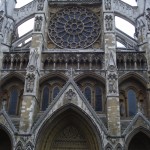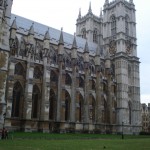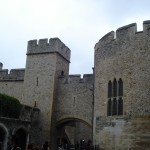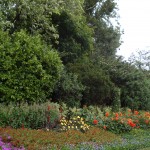September 21st, 2010 · No Comments
The parks of London provide a natural respite from the busy, hectic, and stressful atmosphere of the city. Once in them, you are enveloped by a green tranquil, unable to hear the bustle of cars and people outside the parks’ confines. I have personally experienced this phenomenon at several parks, ranging from Regent’s park (where I ran for the first time since surgery! not a bad debut location), Hyde Park, and most others. This type of division between hustle-bustle and repose mirrors the separation of work and play that Fox often talks about.
However, there is also a clear division within the park of activities that mirrors this division of social and work life. There are areas for sitting contemplatively in very silly chairs, which you are supposedly required to pay for. There are areas for looking at quite nice fountains, sculptures, or gardens. Then there are designated areas for sports, with soccer nets and rugby… posts? Tennis courts seem a bit necessary to be fenced off for convenience’s sake. Several little cafés are sprinkled throughout the parks as well.
Regent’s park matches the above description. I’ve made several trips to this park to run, play a bit of ultimate, have a cup of coffee, or just stroll around and look at the great horticulture. However, all of these activities would occur in different locations in the actual park. This segments the activities, and consequently divides the people that enjoy different forms of recreation. Personally, it made me very uneasy. If I were to throw a disc in the wrong area, I risked getting publicly reprimanded (as classmates have experienced). Anyway – it would take quite a bit of time for me to analyze this division (and I really don’t have the experience or expertise to do so) but there has to be some sociological effect. If you have thoughts on this, just comment on this post.
However, not all parks match this model. St. Jame’s park, home of many venereal diseases during the restoration period, per Dennis’ description, is seemingly built for nothing but comfort and relaxing. There are nice little walks along the lake, a couple bridges, some out-of-place fowl, and many large grassy areas upon which you can sit. However, in a couple walks through the park, I never saw anyone playing catch, football, or any other sport in these large areas. Though it was suspiciously absent of proper monuments (at least, I didn’t see many), the website is careful to highlight the pelican feeding from 2:30-3, and the deck-chairs. Weird. More leisure activities. I should note that there is a quite disproportionately small playground for children. However, as a whole, this is not a built-for-fun park. It is a built-for-relaxing-park, and I think is such because of its close proximity to Buckingham Palace. Green Park, also bordering Buckingham Palace, mirrors this model of relaxation, rather than recreational, with a few monuments (such as the Canada memorial), and is a bit more open green spaces rather than pathways-and-lakes. To me, these two parks are just not okay. I envision parks as a place where you can run around, play whatever kind of games you want. Having fancy gardens in parks just seems to counteract this.
Hyde park, the last park I will discuss in this post, blends athletics and relaxation much like Regent’s. And, just like Regent’s, different activities are segmented. There are different areas for sitting in lawn chairs, areas for tennis, I’ve seen people playing soccer on some of the larger fields (quite far away from the chairs, mind you), and the notorious Speaker’s Corner, completely ostracized from any central location. I suspect that its location is completely intentional whatever authority governs the parks wanted to make sure the… colorful characters that frequent the corner would not pollute (in their mind) the rest of the park.
Well, the parks are divided not only from the city but often divided within themselves. What effect this has on the psyche of park attendees, I’m not sure. Though I love the idea of having large parks in cities, I don’t like this division. If you want to have fancy gardens, just don’t call the whole thing a park.

 That these two photos (both personal) came from the same park (Regent’s) makes little sense to me (though the picture from the right, in my opinion, should not even come from a park).
That these two photos (both personal) came from the same park (Regent’s) makes little sense to me (though the picture from the right, in my opinion, should not even come from a park).
Tags: 2010 ChristopherB
September 15th, 2009 · No Comments
-
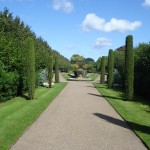
-
Regents Park
-

-
Christ’s Church
-
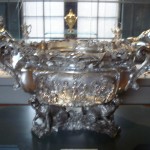
-
The Silver Exhibit in the V&A
-

-
Having a Good Time at the Fitzroy
Like many of my classmates I decided it would be worthwhile to summarize all of my discoveries this month in London. During this post I will focus on six main themes found within London: Parks, Churches, Pubs, Other Religious Institutions, Theatre and Museums.
Parks
Each park that I visited had its own distinct characteristics that separated it from any other. Green Park was the first I visited and after perusing a few others, I realized there was nothing that exciting about it. Located right across from Buckingham Palace, Green Park certainly provides a good place to go and take a break from the busy atmosphere of the area. Besides this however there is not much going on and I would recommend that potential park goers walk the extra distance over to St. James Park.
In addition to the large number of waterfowl heckling people for food which offers consistent entertainment St. James offers some picturesque flower beds throughout and various monuments along the way. It has the relaxing atmosphere of Green Park with a bit more excitement sprinkled in.
Regents Park offers a completely different feel from Green or St. James. Located in a separate area of London, Regents Park has a history of being used by a higher end crowd. I could tell this immediately from the feel of the park. The decorative shrubbery and elegant architecture throughout gave me a feeling that Regents is not as well used as other parks.
Since I was one of the members of the Parks group that gave a walking tour of Hyde Park and Kensington Gardens I could go into a lot more detail about these two green spaces but I will choose not to in an effort to be concise. In summary Hyde Park is the largest green space in London and is often used for larger events such as concerts, festivals etc. It also contains a large number of monuments throughout including the 7/7 memorial and the Diana Memorial Fountain. Kensington Gardens is home to a variety of key monuments but is not as well trodden as Hyde. Overall it makes for a quieter atmosphere, more conducive fo reading or “snogging”.
Regents Park were my two favorite green spaces in London. Regents, is both beautiful, and extremely large and I continually felt the need to go back and explore. Kensington Gardens appealed to me in that it was quainter than Hyde Park but contained a like amount of history and monuments throughout. Although I would be content spending a length of time in any London green space Regents and Kensington would be my top choices.
Theatre
Overall I enjoyed going to the theatre on so many occasions. What better place to do so than in London after all? Here I will discuss my favorite performances and theatre venues.
All in all I enjoyed all but two of the performances we saw. The two Shakespeare productions at The Globe Theatre were fantastic. Although I did not particularly enjoy reading Troilus and Cressida it made a huge difference to be there so close to the actors. The fantastic drum chorus at the end really sealed the deal. As You Like It was probably my favorite show I saw here in London. Although it is one of Shakespeare’s simpler plays the actors really made it jump off the page. Being down it the pit was fantastic because of all the ad-libbing and constant interaction with the crowd. I even felt traces of Touchstone’s saliva on my arm at one point.
The other Shakespeare performance I saw, All’s Well That Ends Well, was lackluster. Although the Olivier was my favorite performing venue (this is what an auditorium style theatre should be like…why can’t Dickinson have something like this?) the play itself was odd and ended on an abrupt and odd note.
The other play we saw at the National Theatre, The Pitmen Painters, was fantastic. Although I was dozing a bit because of the Benadryl I took right before the show, the actors kept my attention and I appreciated that the play was based off of a true story.
Easily the oddest play we saw was Arcadia. An extremely intelligent performance the play juxtaposed two different periods in time and created a singular storyline in which the plot was based. Overall it was an entertaining performance that made me think early and often.
Finally there was Blood Brothers. The lone musical I saw produced feelings of disbelief, anguish and held back laughter. The ridiculous 80’s sound track and creepy narrator just didn’t do it for me. I think it’s safe to say that I was not the only one from Humanities 309 who was a bit surprised to see just about everyone in the audience give it a standing ovation.
I had a very positive experience with the theatre here. I would go back to the globe again and again. I loved being that close to the action. I would also enjoy seeing another show in the Olivier. There really is so much to choose from here. It’s simply a matter of figuring out your tastes and saving your money so you can see a lot of performances.
Churches
From Westminster Abbey to St. Paul’s Cathedral we saw most of the major churches/cathedrals during our month in London. St. Paul’s was easily my favorite. From the fantastic crypt to the hundreds of stairs up to the tower it had so much to offer in the way of history and mystique. Westminster Abbey fascinated me primarily because of all the literary figures that had been buried inside as well as the room that was dedicated to “The Order of the Bath”. Other churches that I really enjoyed taking a look at were: “St. Martin in the Fields” which sits just outside Trafalgar Square and Nicholas Hawkesmoore’s “Christ’s Church” which is located in very close proximity to Brick Lane.
Other Religious Institutions
Overall the Sikh Gurdwara was my favorite place that we visited. I appreciated the simplicity of the religious doctrine as well as the conviction and honesty with which our tour guide, Mr. Singh spoke. The morning was capped off with a fantastic sit down meal together in which everyone was served the same food and drink.
I had different feelings about the Hindu Mandir. It was clear to me from the very beginning that the Hindu religion is not nearly as modest as Sikhism nor are they trying to be. From the extremely decorative prayer room, to the museum located right in the center of the Mandir I never felt particularly comfortable inside.
The only religious institution I wish we had gotten a chance to visit is a Mosque. I had been to one many years ago but I did not remember a whole lot from my experience. I wonder how much more lively the East End, and all parts of London would be if Ramadan were not taking place during our time here.
Museums
I could go on and on about museums so I will attempt to stay as concise as possible.
The British Museum was massive, convenient since it was so close to the Arran House but a little one dimensional at times. One of my favorite exhibits at the British Museum was a special exhibit on Living and Dying that drew information from all different time periods and cultures.
The National Gallery was fantastic. Although I have a hard time appreciating some visual art the gallery kept my attention for a number of hours. Seeing so many famous works of art was phenomenal.
The Tate Modern was my least favorite museum here. Although I am trying I have a hard time understanding modern art. After about 45 minutes in this museum it ended up being too much for me.
The Cabinet War Rooms/Churchill Museum were two of my favorites. The realization that I was standing in one of the most important places in World War II history was unbelievable. The War Rooms felt so authentic. I really felt as though I had been taken back in time to the 1940’s while inside.
The Victoria and Albert was easily my favorite museum in London. There was so much variety inside and so much to see. I could have easily spent a few days inside. Two of my favorite exhibits were the silver and jewelry exhibits. I’m not sure what this says about me as a person but I found it unbelievable that individuals could even own such treasures. I also enjoyed the laid back atmosphere of the V&A staff. At most of the other museums I visited I felt like I was doing them a disservice simply by being there. Although I understand that taking pictures of an object in a museum doesn’t do it justice I like to be able to have the option of doing so.
The Sir John Soane museum interested me but it wasn’t really my cup of tea in the end. It also had a stuffy atmosphere to it that I didn’t really appreciate.
One thing I can draw from my experience at museums here is that each and every one has something that distinguishes it. With so many museums I thought that it would be impossible to avoid some overlap but I never really felt that. Cheers to London and its museums.
Pubs
Finally we have pubs. What would London be without it’s public houses? In some cases pubs are the true museums of London, designating what an area was like in the past and what type of clientele it attracted. During my month here I had a chance to visit a few pubs and get a general sense of what some possible differences could be. It is clear to me that each pub brings something different and unique to the table. The Marlborough Arms was convenient being so close to the Arran House and was a great place to enjoy a pint over a meal with friends. The Court was conducive to socializing in a different way. The music was louder, the people louder and the drinks cheaper. Other places I visited offered other things that made them stand out as well. One thing that i’ve learned about pubs is that it’s hard for one to please everyone. Since everyone has different tastes and desires when it comes to pubs you are better off going to one with a small cohesive group.
To conclude this novel I would just like to say that I think we saw a lot of different faces of London this month. I realize there is much more to see here but between walking tours throughout the city, trips to major monuments and museums and individual exploration I have learned a ton about London, it’s history and where it is going. I look forward to more London explorations in the future but for now, ON TO NORWICH!
Tags: Churches and Cathedrals · Henry · Pubs · Theatre
September 14th, 2009 · 2 Comments
I had the chance to attend the Feminist Literature tour in which I not only learned about women writers who resided in the Bloomsbury area, but also on how spaces affect who we are and everything that we do. I am intrigued with this notion. Recently I posted a blog on space, specifically focused on sacred/holy spaces, in this blog I will look back and focus on a few others others.

Green Green GREEN
Spaces of recreation, golden flowers and perfectly trimmed grass is what I think of. It is impressive to me how well kept they are. When we visited Regent’s Park during class for the first time, I was at a loss of words, for I had never in my life seen a space so beautiful. William Blake captures this beauty in his poem titled “The Lily:”
The modest Rose puts forth a thorn,
The humble sheep a threat’ning horn:
While the Lily white shall in love delight,
Nor a thorn nor a threat stain her beauty bright.
Regent’s Park could not be touched, human hands could never be gently enough to handle a flower’s delicate body. So untouchable, the flowers arranged almost to perfection. Ralph Waldo Emmerson once said that “Earth laughs in flowers,” and I believe him.
Hyde Park, almost as magical, but words cannot capture the immensity of this park. The amount of green that surrounds you at any given moment is difficult to describe. This park in particular serves as more than just a space for recreation, it is also a place where history is preserved, where various neighborhoods unite and where kids grow up to later bring their own kids to play at Kensington Gardens or near the lake. Green Park, a sort of gateway to Buckingham Palace (if you get off at the Green Park Tube station), can never be compared to Hyde Park for it lacks in immensity. Even though the deck chairs are a nice touch to the park, the area I visited lacked some color (as in floral color); I was not impressed. (Buckingham Palace itself was not very impressive. I was surprise to discover that it actually isn’t an enormous, glorious and royal-looking mansion… I guess it’s a good thing that it isn’t after all!)
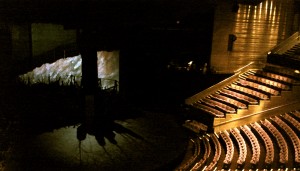
Let’s start the show!!!
Sometimes walking in for the first time takes my breath away, and sometimes the shows blows my mind, other times the idea of sitting there makes me wonder… wow. The three different halls of at the National Theatre, The Globe, Duke of York’s, the Phoenix and last but not least Royal Albert Hall! So here’s the list: “Troilus and Cressida,” “Arcadia,” “All’s Well That Ends Well,” “As You Like It,” “Pitmen Painters” and the not-so awesome musical “Blood Brothers,” oh and the amazing violin concerto at the Royal Albert. In London, I am never too far from New York City’s Broadway experience! The difference, the London experience always feels fulfilling no matter how horrible the play was. This is probably because Broadway shows are not exactly affordable, and while the National Theatre insists on having a wide range of prices (so that everyone can enjoy the theatre), Broadway just seeks revenue and to maintain it’s current status and popularity. I mean, to have Rick Fisher (who by the way is a Dickinson alum), winner of of a Tonny award, come to speak to us about his thoughts and experiences with London’s theatre scene, that within itself was enough to top all of the Broadway shows I have seen in my life! I <3 the London theatre experience!
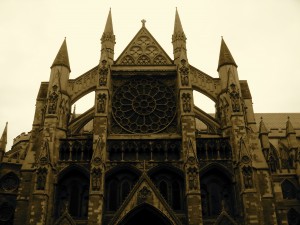
Religious spaces.
Intricate architecture, imagination, creativity and grace is what comes to mind when I think of churches. I’ve written a blog about them but I wanted to look back at a few of them. Westminster, ridiculously sacred, marvelous, immense and glorious. The same can be said about St. Paul’s Cathedral and the Hindu Temple we visited. At Brixton (where I directed a tour along with my teammates), I learned that religious spaces play a huge role in the community, one that extends beyond any religious affiliations. One specific church we visited during our research, Corpus Christi Roman Catholic church was involved in the reconstruction of the Brixton area after the Brixton riots, when parts of the neighborhood where damaged/destroyed due to violent protests. It always brings joy to my heart when people come together to help each other, regardless of any religious/cultural boundaries.

Clubs NOT Pubs
Ooooh pubs…. I’ve heard that you can see London’s history evolve in these spaces, and although they are known as spaces of leisure and social interaction their walls can tell unknown stories of both know and unknown visitors. I am always intrigued by pubs, so intrigued I am intimidated by them. I now that sounds a little ridiculous but in pubs I feel pressured to consume alcohol (after all that is the main purpose of a pub: to provide alcoholic beverages) and to maintain conversation when really all I want to do is dance to the awesome music playing in the background. Rebbeca (who along with 4 others constructed a tour of London’s historic pubs) has attempted to both enlighten me as well as persuade me to engage in pub culture, but I have yet to fully explore the wonderful world of London’s historic pubs.
Clubs, on the other hand, I’ve also had a difficult time with. I’ve realized that there isn’t much dancing that goes on, but rather an attempt to dance, which actually means jumping around to Lady Gaga’s “Just Dance” (pop/techno song). Over all, I have enjoyed late hip hop nights at Metra (dance club a few street corners off the Leichester Square tube stop) only because I have shared that space with amazing people who can turn any floor into a dance floor. (Thanks Anthony, Jeyla and Patsy!)
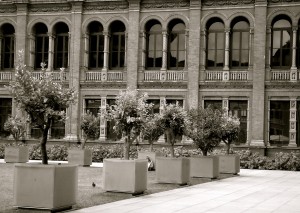
Spaces, our everyday living takes place within them, whether they are churches, clubs, parks or theaters. We lack to realize their importance, we never stop to think of how a room may affect how we feel about ourselves and about the rest of society. A room can change our lives, like the reading room at the British Museum that the feminist writers group spoke of on their tour. This room clearly changed Virginia’s Wolf literature, among other authors, I’m sure.
Note to self: Whether this room is physical or mental, it is important. We must take more time to appreciate a rooms ability to change the way we exist in our own individual worlds.
The End.
Tags: Flow · Uncategorized
September 14th, 2009 · No Comments
Although I have blogged, to some extent, about most academic things I have done in London, I feel that I have a better impression of most things now than I did at the beginning of the stay. Along this vein, I feel the need to revise, or just plain state, my opinions on the “Big Five” topics – parks, churches, museums, theatres, and pubs.
I have now been to five of the Royal Parks in London. Green Park, Kensington Gardens, Hyde Park, Regent’s Park, and St James’ Park are all very similar and yet very different in their own ways. I found Green Park, situated very close to Buckingham Palace, to have the most unfriendly atmosphere of the five. There is very little to Green Park. There are trees, benches, grass, the ever-popular lawn chairs for rent, and beautiful ornate gates facing Buckingham Palace. I think the reason I found the park so cold is that it was, well, too green. There were no flowers or water features (except for one fountain commemorating the Canadians), just trees, grass, and benches.
This is vastly different from the other four parks I visited. St James’ Park, Hyde Park, Regent’s Park, and Kensington Gardens all were beautifully landscaped with brightly colored flowers, clean fountains, scultpures, and natural or constructed water features. In Hyde Park, Regent’s Park, and Kensington Gardens it was easy to forget that you were in the middle of a pollution-filled city. As I am not much of a city person, it was extremely refreshing for me to not be able to hear or see traffic for a while. With Green Park and St James’ Park, I couldn’t shake that feeling. However, I am a firm believer that parks, whether or not they are within city limits, always make people feel healthier. For this reason and the sheer beauty that the parks portrayed in their different ways, I understand why I did not only see tourists, but the people of London as well.
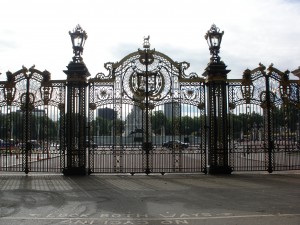
Gates towards Buckingham Palace from Green Park
Churches and other places of worship are an integral part of societies throughout the world. Throughout our time in London, we have been fortunate enough to visit Westminster Abbey, St Paul’s Cathedral, a Sikh gurdwara, and a Hindu temple. Of these four I enjoyed St Paul’s Cathedral the most from a purely historical standpoint and the Hindu temple most from a cultural perspective. St. Paul’s is one of the most recognizable and interesting buildings in London. It not only houses some of the most important military remains in the country (the Duke of Wellington and Admiral Nelson), but it was one of the most iconic images of WWII Britain. I also found it to be less like a museum where I felt like hop-scotching around graves in the floor (Westminster Abbey) and much more like a place of worship.
I enjoyed the Hindu temple for very different reasons. Although there was a definite sense of it being a tourist attraction, with the gift shop in the lobby and the interpretive centre with tiny models of Hindu gods, the temple was still very obviously, well, a temple. Before going there, I had no idea what Hinduism was like. I knew that there are multiple gods and that one is an elephant, but I didn’t know about their dedication to peace and volunteer work. What really struck me about it was that the intricate carving and craftsmanship of the facility was all done by volunteers. I think that this cultural experience was only heightened by being able to observe a service in the sanctuary that was so unlike my own Roman Catholic faith.

St Paul's Cathedral - a symbol and a place of worship
I had very mixed experiences with museums in London. Some, like the Victoria and Albert, I just didn’t seem to understand in the amount of time I spent there. However, I think that if I went back and dedicated a day to the facility, I would appreciate how the seemingly-random exhibits link together much better. (I did enjoy the items on display in the V&A, I just had an issue with the layout of the museum.) Other museums, like the Museum of London and the Docklands Museum, were put together in a very fluid and informative manner that I enjoyed greatly. My two biggest museum issues were with the British Museum and Sir John Soane’s Home/Museum. Grace and I wrote extensively on our thoughts on the British Museum, so instead of repeating everything, I’ll just give a brief summary: why are all of these amazing artifacts that have no connection to Britain in the British Museum?
The Sir John Soane Museum is a completely different story. I appreciated that the museum was free and displayed an extremely eclectic collection, but please never make me go back there ever again! It was the single most claustrophobic place I have ever been in my entire life with possibly one exception. Call it a personal thing, I do not like it when random pieces of monuments are mounted on the ceiling directly above my head. I am also not a big fan of walking into a room in a house and having literally hundreds of sculpture eyes staring at me from every surface around me. I disliked it so much that I could not even finish going through it, and anyone who has been in a museum with me will know that I read and see as much as I possibly can. I don’t understand why that creepy building perfectly-suited to be a haunted house at Halloween is called a museum. (Please if you can attempt to explain it to me, go right ahead!)
Theatre is a subject I have talked about in a couple of different posts (Observations on Accessibility and Blood Painters and Pitmen Brothers), however, I have not discussed theatre in general. I was lucky enough to see Troilus and Cressida, All’s Well That Ends Well, Arcadia, The Pitmen Painters, and Blood Brothers. Each of these theatre experiences were extremely different, but all valuable in their own ways. Troilus and Cressidawas shown in the Globe Theatre and we had groundling tickets that forced us to stand for the 3 hour performance. The actual standing wasn’t nearly as bad as I thought it would be, but the best thing about the show was being quite literally three-to-four feet away from the actors on stage. (Actually, it was slightly amusing when Hector died and was lying 3 feet away in our line of sight for the last 20 minutes of the play!) The staging of this Shakespearian play was vastly different to All’s Well That Ends Well, which was put on in the National Theatre. In the Globe, the sets are quite minimal because they have to perform four or five different shows on the same stage in the space of a few days. The set for All’s Well That Ends Well was much more elaborate and specialized for the show. Rather than the reliance on the actors and the costumes that the Globe used to tell you where the play was occurring, All’s Well That Ends Well used a dark set with elaborate staircases to add to the mood of characters and the dialogue.
Much like with Troilus and Cressida, the set for Arcadia was also pretty simple. Although the play took place in two different years, it was set in exactly the same room with almost all of the same props. This was a very effective way to stage the show and allowed for the writer, Tom Stoppard, to do some very interesting things with the characters from both time periods, like when he had them all in the room at the same time, oblivious to each other. I particularly enjoyed the way that this play was set and how basic it was. It was vastly different from the more complicated sets of The Pitmen Painters, which included projection screens, and Blood Brothers, which had lots of windows for the Devil/God character to peer creepily out of.
This final subject I have not blogged about at all. Pubs are an integral part of British culture. That said, pubs are also an integral part of Irish culture, so I experienced pub life when I lived in Ireland. British pubs and Irish pubs have a lot of similarities and differences. In both places, you must push viciously up to the bar in order to get your food and drink, you have to be 18 to have alcohol, smoking must be done outside, and there are usually way too many people in the pub for you to feel comfortable. Oh, and you always pay way more than you think you should for your drink. I’ve been to a couple of pubs in London and have found that they are all fairly similar. The bartenders are nice, but kind of frantic; the food is good, and usually relatively cheap; and the music is God-awful 1980s or techno playing at volumes that are way too loud. The first two are cohesive with pretty well every Irish pub I’ve ever been in, the third is not. Irish pubs play good music… or at least much better music than I’ve heard here! There are a lot of pubs that have a band playing traditional Irish music in front of you in the pub for pints and there are also a lot that play modern music at volumes that make my ears want to cry – but at least the music isn’t a Cher and Meatloaf duet accompanied with the weirdest music video I have ever seen in my entire life. (This particular musical masterpiece was played in The Court the other day. I never would have thought of that particular combination, but oooooookkkkkkkkkk.) Truth be told, I just want to find a comfortable pub with some good music and that will make me just as happy as George Orwell’s fictitious Moon Under Water.
Tags: Churches and Cathedrals · Kelley · Museums · Pubs · Theatre
After an early breakfast at the Arran House and a short walk through a light mist back to Trafalgar Square I had a chance to cross some more major sites off my list today. The first of these was Westminster Abbey. The entire class was taken on a thorough tour of the Abbey by John, a knowledgeable, excitable man who made the tour a captivating experience throughout despite the fact that my feet were aching terribly by the end of the two hour experience. Prior to the tour starting I spent a few minutes gazing at the magnificent building from the outside and found myself immediately in awe by both the innate architecture and simply the sheer size of the building. This feeling increased tenfold once we entered. After walking past the courtyard we entered into the nave where I was once again impressed by the beautiful architecture. The tour consisted of a little bit of everything including the tombs of past monarchs, the Grave of the Unknown Warrior and a section dedicated entirely to writers of England. All of these sites caught my attention and stuck with me but my favorite part of the Abbey by far was The Lady Chapel. The many Saints delicately carved into the sides of the room was miraculous. Each one was designed so intricately that even the smallest features were easily discernible. The thing that fascinated me the most inside The Lady Chapel was the Order of the Bath. Each knight in the Order had their own individual flag and seal which they displayed prominently over their seat. Each and every flag was unique and told a different story about the individual that they represent. I found it interesting that knights are sometimes forced to wait a number of years to have their flags displayed because they are required to wait until the person who holds the spot before them passes away before their spot is opened up. After walking through The Lady Chapel I had a sudden urge to design my own flag and copper stall-plate and maybe even start my own Order of the Bath. We will see…
After a pub lunch at the Red Lion, located just a few minutes from the Abbey, Alli, Becca, Chelsea, Kim, Mara, Sarah and I headed to the Tower of London. Heading in with “great expectations” I have to say I was a bit disappointed overall. It was interesting to walk through the ancient monument but I had no idea it would draw the massive number of tourists it did. All ages were represented but I was very surprised to see a large amount of young children walking through the tower, a number of them unaccompanied by adults. The highlight of the Tower of London experience was the Crown Jewel exhibit. After being instructed to put our cameras away we were taken into a room with pressurized doors where we examined crowns that monarchs wore. In addition to the crowns we saw diamond laden rings, sceptors and golden cutlery that made our jaws drop. The most amazing object I observed was a giant punch bowl made entirely out of gold and must have weighed over 18 kilograms. Completely and utterly unbelievable! After the Crown Jewels exhibit my time at the tower went South. Due to the amount of loud, rambunctious children present and a subpar exhibit on torture in the Tower we walked through I was ready to leave after about two hours. Overall my experience was not a completely negative one. Being inside the grounds was breathtaking and the architecture amazed me. However I do not see myself returning here during the rest of my time in London.
After our time in the Tower Alli, Kim, Mara, Sarah and I decided to get an early start on our walking tour project. Since our general theme is parks in London we decided it would be a good idea to visit a couple of the major green spaces in the area. We hopped on the tube and took the central line to St. James Park station. Upon arrival we spent some time moseying around Buckingham Palace and Victoria’s Memorial before getting down to business and taking a stroll through Green and St. James Park. Nothing too exciting was going on at Green Park. At one point we sat down in light green lawn chairs only to be told that we had to pay a fee in order to sit. We quickly dismissed Green Park as a space that we would focus our project on. St. James however was a different story. We immediately spotted water and wandered over where we discovered a multitude of birds including ducks, geese and pigeons. These birds were not afraid to come close to humans at all and we saw many eating out of the hands of children who were offering them bread despite the numerous signs that clearly read “don’t feed the birds”. We wandered through most of the park, passing beautiful lush flower gardens along the way. Overall St. James seemed more alive then Green Park and we definitely plan on heading back to take another look when the Park Office is open and we can receive more information about it’s history.
Today was a very rewarding day overall. I am happy to say that I was able to visit some of the most historic places in the country in one day and ecstatic that my experience at Westminster Abbey went so positively. I’m amazed at just how much I have been able to see in one week here and I know that I continue to see more and more incredible places during my time here in London. Next up: Stonehenge!
Tags: Churches and Cathedrals · Henry

 That these two photos (both personal) came from the same park (Regent’s) makes little sense to me (though the picture from the right, in my opinion, should not even come from a park).
That these two photos (both personal) came from the same park (Regent’s) makes little sense to me (though the picture from the right, in my opinion, should not even come from a park).











